Link to Pubmed [PMID] – 32430568
Link to DOI – 10.1007/s11262-020-01764-2
Virus Genes 2020 Aug; 56(4): 472-479
The circulation of highly pathogenic avian influenza viruses (HPAIVs) of various subtypes (e.g., H5N1, H5N6, H5N8, and H7N9) in poultry remains a global concern for animal and public health. Migratory waterfowls play important roles in the transmission of these viruses across countries. To monitor virus spread by wild birds, active surveillance for avian influenza in migratory waterfowl was conducted in Mongolia from 2015 to 2019. In total, 5000 fecal samples were collected from lakesides in central Mongolia, and 167 influenza A viruses were isolated. Two H5N3, four H7N3, and two H7N7 viruses were characterized in this study. The amino acid sequence at hemagglutinin (HA) cleavage site of those isolates suggested low pathogenicity in chickens. Phylogenetic analysis revealed that all H5 and H7 viruses were closely related to recent H5 and H7 low pathogenic avian influenza viruses (LPAIVs) isolated from wild birds in Asia and Europe. Antigenicity of H7Nx was similar to those of typical non-pathogenic avian influenza viruses (AIVs). While HPAIVs or A/Anhui/1/2013 (H7N9)-related LPAIVs were not detected in migratory waterfowl in Mongolia, sporadic introductions of AIVs including H5 and H7 viruses into Mongolia through the wild bird migration were identified. Thus, continued monitoring of H5 and H7 AIVs in both domestic and wild birds is needed for the early detection of HPAIVs spread into the country.

